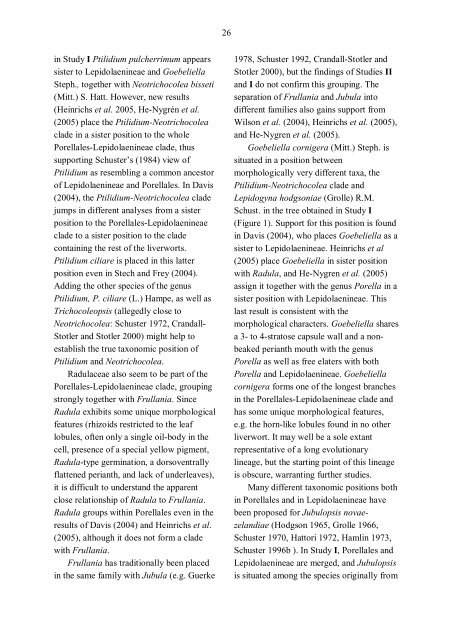Evolutionary relationships of liverworts with a special focus ... - Doria
Evolutionary relationships of liverworts with a special focus ... - Doria
Evolutionary relationships of liverworts with a special focus ... - Doria
Create successful ePaper yourself
Turn your PDF publications into a flip-book with our unique Google optimized e-Paper software.
26<br />
in Study I Ptilidium pulcherrimum appears<br />
sister to Lepidolaenineae and Goebeliella<br />
Steph., together <strong>with</strong> Neotrichocolea bisseti<br />
(Mitt.) S. Hatt. However, new results<br />
(Heinrichs et al. 2005, He-Nygrén et al.<br />
(2005) place the Ptilidium-Neotrichocolea<br />
clade in a sister position to the whole<br />
Porellales-Lepidolaenineae clade, thus<br />
supporting Schuster’s (1984) view <strong>of</strong><br />
Ptilidium as resembling a common ancestor<br />
<strong>of</strong> Lepidolaenineae and Porellales. In Davis<br />
(2004), the Ptilidium-Neotrichocolea clade<br />
jumps in different analyses from a sister<br />
position to the Porellales-Lepidolaenineae<br />
clade to a sister position to the clade<br />
containing the rest <strong>of</strong> the <strong>liverworts</strong>.<br />
Ptilidium ciliare is placed in this latter<br />
position even in Stech and Frey (2004).<br />
Adding the other species <strong>of</strong> the genus<br />
Ptilidium, P. ciliare (L.) Hampe, as well as<br />
Trichocoleopsis (allegedly close to<br />
Neotrichocolea: Schuster 1972, Crandall-<br />
Stotler and Stotler 2000) might help to<br />
establish the true taxonomic position <strong>of</strong><br />
Ptilidium and Neotrichocolea.<br />
Radulaceae also seem to be part <strong>of</strong> the<br />
Porellales-Lepidolaenineae clade, grouping<br />
strongly together <strong>with</strong> Frullania. Since<br />
Radula exhibits some unique morphological<br />
features (rhizoids restricted to the leaf<br />
lobules, <strong>of</strong>ten only a single oil-body in the<br />
cell, presence <strong>of</strong> a <strong>special</strong> yellow pigment,<br />
Radula-type germination, a dorsoventrally<br />
flattened perianth, and lack <strong>of</strong> underleaves),<br />
it is difficult to understand the apparent<br />
close relationship <strong>of</strong> Radula to Frullania.<br />
Radula groups <strong>with</strong>in Porellales even in the<br />
results <strong>of</strong> Davis (2004) and Heinrichs et al.<br />
(2005), although it does not form a clade<br />
<strong>with</strong> Frullania.<br />
Frullania has traditionally been placed<br />
in the same family <strong>with</strong> Jubula (e.g. Guerke<br />
1978, Schuster 1992, Crandall-Stotler and<br />
Stotler 2000), but the findings <strong>of</strong> Studies II<br />
and I do not confirm this grouping. The<br />
separation <strong>of</strong> Frullania and Jubula into<br />
different families also gains support from<br />
Wilson et al. (2004), Heinrichs et al. (2005),<br />
and He-Nygren et al. (2005).<br />
Goebeliella cornigera (Mitt.) Steph. is<br />
situated in a position between<br />
morphologically very different taxa, the<br />
Ptilidium-Neotrichocolea clade and<br />
Lepidogyna hodgsoniae (Grolle) R.M.<br />
Schust. in the tree obtained in Study I<br />
(Figure 1). Support for this position is found<br />
in Davis (2004), who places Goebeliella as a<br />
sister to Lepidolaenineae. Heinrichs et al<br />
(2005) place Goebeliella in sister position<br />
<strong>with</strong> Radula, and He-Nygren et al. (2005)<br />
assign it together <strong>with</strong> the genus Porella in a<br />
sister position <strong>with</strong> Lepidolaenineae. This<br />
last result is consistent <strong>with</strong> the<br />
morphological characters. Goebeliella shares<br />
a 3- to 4-stratose capsule wall and a nonbeaked<br />
perianth mouth <strong>with</strong> the genus<br />
Porella as well as free elaters <strong>with</strong> both<br />
Porella and Lepidolaenineae. Goebeliella<br />
cornigera forms one <strong>of</strong> the longest branches<br />
in the Porellales-Lepidolaenineae clade and<br />
has some unique morphological features,<br />
e.g. the horn-like lobules found in no other<br />
liverwort. It may well be a sole extant<br />
representative <strong>of</strong> a long evolutionary<br />
lineage, but the starting point <strong>of</strong> this lineage<br />
is obscure, warranting further studies.<br />
Many different taxonomic positions both<br />
in Porellales and in Lepidolaenineae have<br />
been proposed for Jubulopsis novaezelandiae<br />
(Hodgson 1965, Grolle 1966,<br />
Schuster 1970, Hattori 1972, Hamlin 1973,<br />
Schuster 1996b ). In Study I, Porellales and<br />
Lepidolaenineae are merged, and Jubulopsis<br />
is situated among the species originally from
















